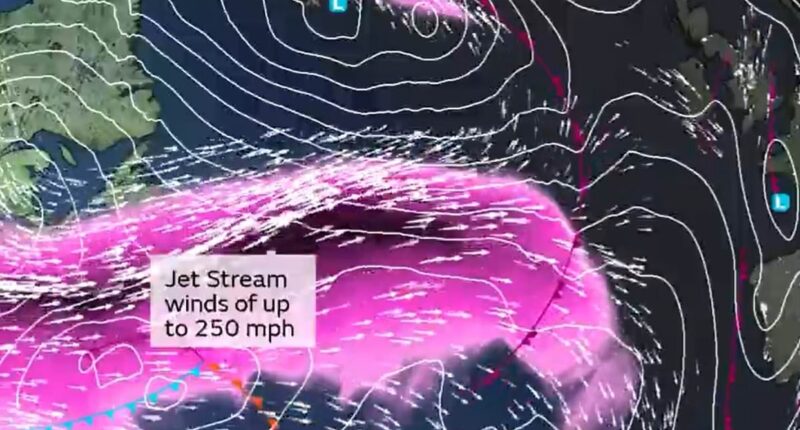Britain could be affected by its first named storm of the year on Friday as meteorologists are warning of a ‘very powerful’ weather system forming over the Atlantic Ocean.
Gusts reaching up to 80mph are expected to impact western Scotland, with speeds of 60 to 70mph forecasted for the rest of Scotland, North West England, North West Wales, and Northern Ireland.
The Met Office has indicated that the intense low-pressure system may result in ‘potentially disruptive weather,’ including heavy rainfall and snowfall sweeping across the UK within the next four days.
A 36-hour yellow wind warning was issued this morning for western Scotland and all of Northern Ireland, running for the whole of Friday until 12pm on Saturday – with a ‘weather bomb’ expected to develop in the Atlantic on Thursday morning.
The Met Office said the ‘very strong’ south-easterly to south-westerly winds could cause damage to buildings, public transport disruption, road or bridge closures and power cuts – while ‘injuries and danger to life could occur from flying debris’.
And it urged those in the warning area: ‘Prepare to protect your property and people from injury. Check for loose items outside your home and plan how you could secure them. Items include; bins, garden furniture, trampolines, tents, sheds, and fences.’
Meteorologists will be examining various forecast models over the coming days and will decide whether to name the storm as Éowyn, after 96mph Darragh on December 6, Conall on November 27, Bert on November 22 and Ashley on October 20.
Forecasters said a strong temperature contrast from the clash of tropical and Arctic air will fuel a ‘very powerful’ Jet Stream with winds of up to 250mph.
The Jet Stream will develop above the North Atlantic this week, with the Met Office expecting ‘perhaps the strongest winds of the winter so far’ by Friday.




Its forecast said: ‘The change to much more unsettled conditions will begin on Friday as a deep area of low pressure, which is yet to develop, will be steered towards the UK on a powerful Jet Stream – fuelled by the recent cold spell over North America.
‘A wet and windy few days are likely, with some snow in the north for a time, and then a continuation of these periods of rain followed by showers, often accompanied by strong winds, looks likely for the rest of the month and the start of February.
‘There is the potential for weather warnings or even a named storm at some point. Temperatures at least should recover in most places, ending up a little above average, though admittedly not feeling like it at times.’
The storm is expected undergo explosive cyclogenesis – a term more commonly known as a ‘weather bomb’ – in the Atlantic on Thursday.
This criteria is met when the central pressure of a low pressure system falls by more than 24 millibars in 24 hours.
Marco Petagna, senior operational meteorologist at the Met Office, said the central pressure of this low in the Atlantic may deepen by 35 millibars in the first 12 hours of Thursday.
He described this as ‘pretty remarkable’ in a tweet, given that the system would easily pass the weather bomb criteria in just half the time required.
Before then, grey and gloomy weather is forecast to continue this week.
The Met Office said today and tomorrow would be ‘fairly benign’, with many across the UK continuing to see cloud and spots of rain.
Parts of England and Wales will see breaks in the cloud but temperatures are forecast to be ‘a bit chilly’ with an average of 8C or 9C.
The coldest city temperature this morning was -3C in Aberdeen, while Manchester fell to 2C, London 3C, Glasgow 6C and Belfast 7C.




And the UK Health Security Agency has a yellow cold weather health alert in place for all of England apart from the South West until 9am tomorrow.
Tomorrow is expected to be slightly brighter before Wednesday sees the beginning of ‘more unsettled’ conditions.
Craig Snell, a meteorologist at the Met Office, said: ‘The middle of the week will see a mix of cloud, brightness and spots of rain.
‘Overall, conditions are expected to become gradually more unsettled. But Thursday is where we will start to see a more significant change across the country.
‘We’re expecting to see more rain accompanied by stronger winds. Temperatures will also be below par for what we usually see at this time of year.’
Friday’s forecast is expected to bring ‘more notable’ wind and rain.
The strongest winds will be towards the North West of the UK but overall it will be much windier than it has been over the last few days.
Mr Snell said: ‘Temperatures are expected to remain mostly average, though parts of the north could see small spells of snow. We’re just keeping an eye on things for now.
‘But overall conditions are expected to gradually become more unsettled as the week goes on. The working week across the entirety of the UK will start like it’s been for the last few days. But by the end things will be very different.’
It comes after a chilly weekend that saw a UK low temperature of -6.9C at Aboyne in Aberdeenshire yesterday, while the high was 12.1C at St Mary’s on the Isles of Scilly.



A Met Office yellow wind warning will run for the whole of Friday until 12pm on Saturday
The coldest day of the year so far was January 11 when Altnaharra in the Scottish Highlands plunged to -18.9C (-2F) – which was also the UK’s coldest January overnight temperature since 2010.
The warmest day of 2025 so far was last Tuesday, when Cassley in the Highlands reached 15.7C (60.3F). In addition, this was a new date record for the highest UK temperature on January 14 since records began.
That also meant there was a 34.6C (62.3F) swing in temperatures in just three days in northern Scotland, between January 11 and 14.
The average low in northern Scotland for this time of year is -0.3C (31.5F), while for England, overnight lows are normally about 1.5C (34.7F).

















